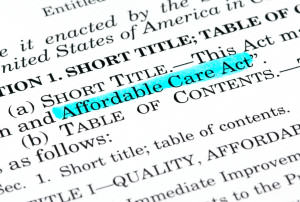
For 2015 reporting, ALEs are defined as employers with 100 or more full time employees (including FTEs) for the 2014 calendar year. ALEs are required to provide health coverage to at least 70% of qualifying employees to avoid non-coverage penalties. For 2016 and beyond the percentage of coverage needed jumps to 95%. Small businesses with 50-99 FTE will need to start insuring full-time workers by 2016. The mandate does not apply to employers with 49 or less FTE.
The forms will not be filed until January 2016, however the information must be reported for each month of 2015. Therefore, it is critical for employers to ensure their internal time and attendance, record management, and payroll systems are capable of producing the required information.
The ACA monthly reporting requirements include collecting and disclosing the following information:
- Total amount of full-time employees for each month (EPAY’s ACA Toolkit can help)
- Total number of full-time equivalent employees for each month (EPAY’s ACA Toolkit can help)
- Section 4980H transition relief[i] indicators for each calendar month
- Employees’ share of the lowest-cost monthly premium for himself only, minimum value coverage for each calendar month (EPAY’s ACA Toolkit can help)
- Applicable Section 4980H safe harbor[ii] (including Rate of Pay, Federal Poverty Line and Conditions for Using the Affordability Safe Harbors) indicators for each calendar month
- The Social Security Numbers for employees, their spouses and their dependents
- The names and employer ID numbers (EINs) of other employers within the reporting employer’s controlled group of corporations (parent-subsidiary or brother-sister business relationships) for each month
How EPAY’s Time and Attendance System Can Help You Prepare for ACA Monthly Reporting Requirements
Although these reporting requirements appear cumbersome, technology will ease the burden by automating the data collection portion of the reporting requirements. This is especially critical for employers who have seasonal or “variable hour employees”. Variable hour employees refer to employees with work schedules that fluctuate making it hard for employers to discern full time or part time status.
Since so much of the ACA rules revolve around precisely tracking employee “hours of service”, having an automated time and attendance system with advanced reporting capabilities is of utmost importance. With EPAY Systems’ Affordable Care Act Toolkit, you have access to reports, dashboards and calculators that prepare you to tackle ACA requirements.
Learn How the ACA Toolkit Can Help You Meet ACA Requirements
Download the 1-page guide on the ACA Toolkit today.
[i] An employer with at least 50 but fewer than 100 full-time employees (including FTEs) will not be assessed a penalty tax under Section 4980H(a) or (b) for any calendar month in 2015 or, for employers with non-calendar year plans, for any calendar month in the 2015 plan year, including months that fall in 2016, if the employer meets certain requirements.
To qualify for the transition relief, the employer must employ at least 50 but fewer than 100 full-time employees (including FTEs) on business days during 2014. This determination is made on a controlled group basis.
The employer may not, between February 9, 2014 and December 31, 2014, reduce the size of its workforce or the overall hours of service of its employees in order to qualify for the transition relief, but may make such reductions for bona fide business reasons. In addition, the employer may not eliminate or materially reduce healthcare coverage offered, if any, on February 9, 2014 through the end of the 2015 plan year. The final regulations provide additional information as to what constitutes an elimination or material reduction of healthcare coverage.
The employer must file a Certification of Eligibility for Transition Relief that it meets the eligibility requirements above. It is anticipated this form will be filed with the employer’s filing under Internal Revenue Code Section 6056.
For employers first coming into existence in 2015, the transition relief above will apply if the employer (i) reasonably expects to employ – and actually employs – fewer than 100 full-time employees (including FTEs) on business days during 2015; (ii) reasonably expects to meet the standards above regarding maintaining the size of its workforce, aggregate hours of service, and previously offered healthcare coverage, as measured from the date the employer is first in existence; and (iii) files a Certification of Eligibility for Transition Relief as described above.
Source: http://moulderlaw.com/relief-confusion-associated-with-%C2%A74980ha-transition-relief/
[ii] Recognizing that employers will generally not know an employee’s household income, the IRS outlined a proposed affordability safe harbor (referred to as the W–2 safe harbor) in prior notices. The proposed regulations provide two additional safe harbors for determining affordability.
W-2 Safe Harbor– An employer will not be subject to an assessable payment if the required employee contribution toward the self-only premium for the employer’s lowest cost coverage that provides minimum value, does not exceed 9.5 % of the employee’s W–2 wages.
Rate of Pay Safe Harbor– An employer can take the hourly rate of pay for each hourly employee and multiply that rate by 130 hours per month to determine a monthly “rate of pay.” The employee’s monthly contribution amount (for the self-only premium of the employer’s lowest cost coverage that provides minimum value) is affordable if it is equal to or lower than 9.5% of the computed monthly wage estimate. For salaried employees, monthly salary would be used instead of hourly salary multiplied by 130.
Federal Poverty Line Safe Harbor- An employer may also rely on a design-based safe harbor using the Federal Poverty Level (FPL) for a single individual. Coverage offered to an employee is affordable if the employee’s cost for self-only coverage does not exceed 9.5% of the FPL for a single individual. For example, in 2012 affordable coverage under this method would have been set at a monthly contribution in the lower 48 states of $88.43 for self-only coverage (FPL is slightly higher in Alaska and Hawaii).
